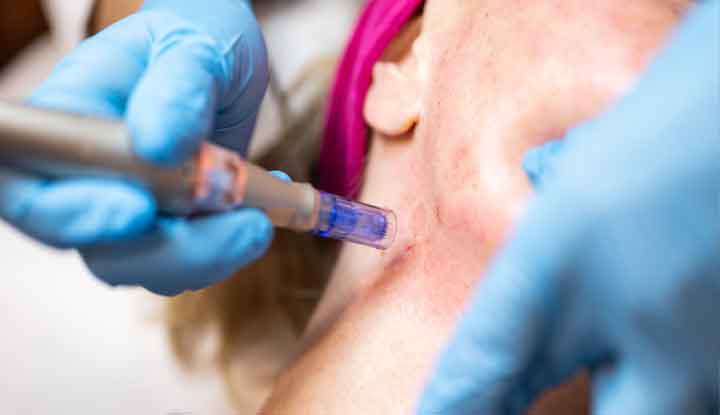Microneedling is a minimally invasive procedure using thin needles. The procedure can help reduce the appearance of skin concerns such as acne scars, stretch marks or wrinkles. Most people get microneedling for cosmetic purposes, but it can also help with some medical conditions.
Advertisement
Cleveland Clinic is a non-profit academic medical center. Advertising on our site helps support our mission. We do not endorse non-Cleveland Clinic products or services. Policy

Microneedling is a minimally invasive procedure for your skin. Your healthcare provider uses thin needles to make tiny holes in the top layer of your skin. The damage helps stimulate your skin’s healing process, so it produces more collagen and elastin. These proteins keep your skin firm and smooth.
Advertisement
Cleveland Clinic is a non-profit academic medical center. Advertising on our site helps support our mission. We do not endorse non-Cleveland Clinic products or services. Policy
Most people get microneedling on their face, but you can also get it on your legs, back, neck or other areas where you notice damaged or aging skin. You’ll probably need multiple treatments to achieve your desired results.
Microneedling and microdermabrasion are both procedures to improve the look and texture of your skin. But microdermabrasion doesn’t use needles. Instead, a healthcare provider uses a device with a rough edge, like sandpaper, to exfoliate the uppermost layer of your skin. Microneedling goes deeper into your skin than microdermabrasion, so it might work better for problems beneath the surface, such as acne scars.
Microneedling has cosmetic and medical uses. You might consider microneedling if you’re concerned about:
The procedure can also help people who have medical conditions such as:
In some cases, healthcare providers use microneedling to deliver drugs or vaccines directly into your skin. The microneedles might be part of a patch that people apply themselves instead of going to their healthcare provider for shots.
Advertisement
Talk to your healthcare provider before getting microneedling if you have:
Before microneedling, you have a consultation with a healthcare provider. A plastic surgeon, dermatologist or aesthetician might perform microneedling. Make sure that whoever does the procedure has experience in this technique.
Your healthcare provider will examine your skin, review your health history and discuss your goals for the procedure. They may also take photos of the area so you can compare your skin before and after microneedling.
This is a good time to ask any questions you may have about microneedling, such as:
About a month before treatment, your healthcare provider may ask you to apply vitamin A or C cream to your skin. These creams can help start the process of collagen production.
Your healthcare provider cleans your skin and applies a numbing cream or ointment, such as lidocaine gel. They do this about 30 minutes to 45 minutes before your procedure, so the ointment has time to work.
Next, your healthcare provider uses a hand-held roller or an electric tool to make the wounds in your skin. The roller has tiny needles. Your healthcare provider rolls it slowly and gently across your skin. If they use the electric device, needles pulse up and down to puncture your skin. They can change the length of the needles on the electric device. Longer needles go deeper into your skin, which might be necessary if you have deep scars or pockmarks from acne. Needle lengths can range from 0.5 millimeters to 2 millimeters.
You might feel warmth or a scratching sensation on your face once the microneedling starts. Some people feel discomfort if the needles are near bony areas, such as your cheekbones. Deep microneedling might cause a little bleeding.
A microneedling procedure can take anywhere from 15 minutes to a few hours, depending on the size of the area that needs treatment.
Microneedling is an outpatient procedure, so you can go home once it’s done. Your skin might be red and swollen for up to five days. An ice pack can help reduce irritation and discomfort. Most people can wear makeup the day after the procedure, but you should stay out of the sun until your skin heals.
Advertisement
Microneedling is a safe procedure, but risks may include:
Microneedling can help improve the appearance and texture of your skin. It can minimize stretch marks, scars, wrinkles and other skin concerns.
It doesn’t carry the risk of skin discoloration, unlike some facial rejuvenation procedures that use heat, light or lasers. This makes microneedling ideal for people with darker skin tones.
In the days and weeks after microneedling, you might notice that your skin burns or feels tight. Some people also have dry, flaking skin that improves with moisturizer.
Most people need multiple microneedling treatments, usually about 3 weeks to 8 weeks apart. It can take 3 months to 6 months to see results. Afterward, you might need the procedure once a year for maintenance.
Contact your healthcare provider if you notice the treated area is:
You may want to ask your healthcare provider:
Microneedling is a minimally invasive procedure that can improve the appearance of your skin. Talk to your healthcare provider about microneedling if you have acne scars, stretch marks or other skin concerns. It’s a safe outpatient procedure. Most people need multiple treatments over several months to achieve their desired results.
Advertisement
Every day, people see your skin, hair and nails. At Cleveland Clinic, our expert and caring dermatology team will make sure they’re healthy and strong.

Last reviewed on 05/23/2022.
Learn more about the Health Library and our editorial process.